

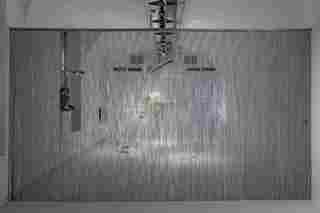
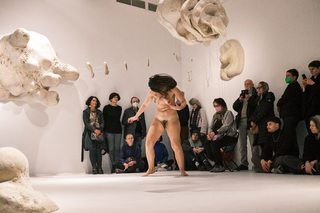
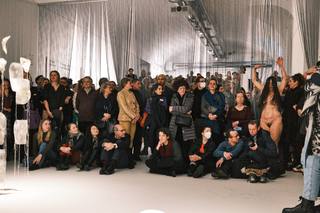
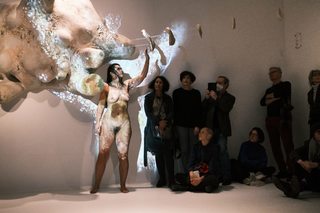
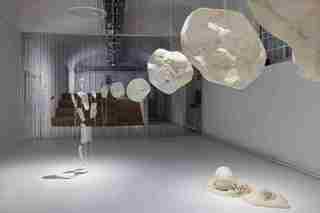

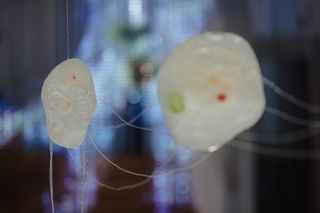

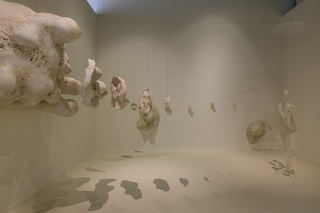
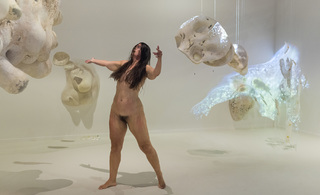
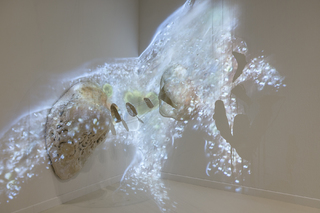

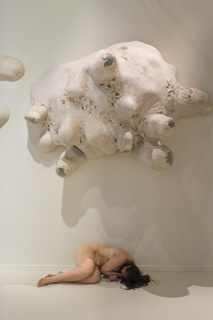

performance 2021-2022
ENTANGLED RELATIONS – ANIMATED BODIES
Unknown Unknowns, An Introduction to Mysteries
23rd Triennale Milano International, Performed Installation
One of the central paradoxes of anatomy [is] the use of dead bodies to teach about living ones.1
When looking at the history of anatomical depiction over the past centuries, we notice a radical change in what “being human” means, in a medical, biological, social, and cultural sense. Analyzing anatomical images allows us to see how conceptions of the self, ideas about what it means to be a person, and related knowledges or overall beliefs have changed over time. Furthermore, the study of anatomical models helps us decipher how historically specific conventions of collaboration and correspondence, as well as mutual rejection or opposition, between artists and anatomists have provoked epistemological and ontological shifts in understandings of human embodiment. While early illustrations in anatomical studies 2 showed a rich ensemble of imaginary figurations and artistic adornments that contained humor, playfulness, and allusion, “today’s scientific imaging sticks to a straight and narrow path that does not allow deviations or correspondences between the anatomical body and the moral, political, and social world, fun and pleasure.”3 Images of the self are closely related to a person’s inner reality, to one’s sense of self and others, and to the intimate perception of one’s own body. However, images of human bodies are also dependent on emergent market practices and social identities, cultural definitions of the private and the public sphere, and ongoing processes of state formation and community building. Modeling bodies in a mental and physical sense is also a way of modeling community.4
[When] I think about my body and ask what it does to earn that name, two things stand out. It moves. It feels. In fact, it does both at the same time.5
How, then, can anatomical models be modeled, shown, seen, and experienced so that they represent the living body? Entangled Relations—Animated Bodies attempts to shape alternative corporeal models to unsettle representations of the static body and to celebrate the ephemeral and the animated body, while illustrating the collapse of epidermic and trans-species boundaries.
The project is animated by amoebas’ ability to alter their shape by extending their liquid skin and by their ability to blur what is and what is not an “individual.” “Amoeba colonies have the ability to morph from a seemingly un- coordinated group of genetically identical single cells into an aggregate ‘slug’ with an immune system, muscles, and nerves with ganglia (that is, simple brains) and other organismic functionalities characteristic of multicellular species with different roles played by identical cellular units. Social amoebas queer the nature of identity, calling into question the individual/group binary.”6
Why should our bodies end at the skin, or include at best other beings encapsulated by skin?
7
Hundreds of thousands of microorganisms of different beings, including bacteria, archaea, eukaryotes, viruses, yeasts, and parasites live in, on, and around a single body and keep it alive. Humans are walking biotopes, which depend on the cooperation of these different life forms in, on, and around the body for survival.
How can we think of bodies beyond the singular, as always multiple and many? No matter how much we try to distance ourselves from the multi-being world by sterilizing and isolating our bodies, we must finally accept that we are just a tiny interdependent part of the environment, within a constantly adapting and fluid co-evolution. It appears that we are slow to understand that we cannot escape the vital relations and entanglements between bodies and their ecosystems, rooted in “more-than-human sociality”8 and microbial heritage. That said, there is an urge to awaken human bodies in order to rethink, reshape, and deepen the comprehension of elementary aspects of our being-in-the-world.
Inspired by Jules Sturm’s concept of the absence of bodies in bodily representations, I am convinced that the human body can only be represented in and through aliveness and movement. Hence, performance appears to be the most suitable approach for actualized, contemporary, dynamic corporeal “models.” Sturm uses the concept of bodily absence as a tool to analyze the correlation between the bodies’ absence in images which de-pict them.
If viewers are confronted with the negative aspect of visual presence in art, they become aware of the constructed relation between living bodies and their representations. [...] The idea of absence disrupts the seeming coherence of this relation, and helps to develop alternative ways of imaging or imagining those bodies that have been subjected to representational stereotyping and pictorial neglect.9
What if we imagine the human body as a locus of muddled and entangled relations, “thinking against categories such as species, sex, [...] as a locus of social and biological categories in motion and in transition?”10
Through this performed installation, Entangled Relations— Animated Bodies aims to make the inseparable and seemingly invisible entanglements and relations among bodies and their ecosystems (human and more-than-human) visible, tangible, walkable, wearable, recognizable, readable, and changeable. The focus of the artwork lies on the dynamic play with the viewer’s perception through which the “anatomy” of a human body cracks and breaks open. Within such a context, the boundaries of the human body dissolve and skin becomes blurry and fluid, suggesting that the human figure is never to be considered singular, but continuously shaped by and interdependent on its environments.
By unfolding, shifting, and decomposing the so-called “body boundary,” the artwork exposes the relations be- tween the responsive, moving, seeing, and touching body, and its perpetual exchange with its sustaining milieus, revealing unknown forms of movement, intelligence, and communication.
In this way, Entangled Relations—Animated Bodies expresses the potential for enlivening the anatomical model as a performative walking biotope, engaging the imaginary and the factual in a mutual dialogue. By doing so, the project creates an environment that inspires the visitor to reflect about, yet also to wonder, feel, touch, enjoy, and understand, what it might mean to embody “the human” today.
1 Bleeker, Maaike, “Martin, Massumi, and The Matrix,” in: id. (ed.), Anatomy Live: Performance and the Operating Theatre, Amsterdam: Amsterdam University Press 2008, 151–164: 151.
2 E.g., De humani corporis fabrica, the revolutionary work of Andreas Vesalius, 1543.
3 Sappol, Michael, Dream Anatomy. Philadelphia: U.S. Department of Health and Human Services 2006.
4 Text abstract by Sonja Bäumel
and Birgit Nemec from Fifty Percent Human Project. The project ran from October 2015 until October 2016 and was kindly supported by the Creative Industries Fund NL, AFK (Amsterdam Fund for the Arts), and the Wageningen University. www.sonjabaeumel.at/work/ fifty+percent+human/ [14 Apr 2022].
5 Bleeker 2008 (see note 1): 152.
6 Barad, Karen, “Intra-actions,” interview of Karen Barad by Adam Kleinmann, in: Mousse Magazine 34 2012 [issue on dOCUMENTA (13)], 76–81: 77.
7 Haraway, Donna J., “A Cyborg Manifesto: Science, Technology,
and Socialist-Feminism in the Late Twentieth Century,” in: id., Simians, Cyborgs, and Women: The Reinvention of Nature, New York/London: Routledge 1991, 149–182: 178.
8 Tsing, Anna, “More-than-Human Sociality: A Call for Critical Description,” in: Hastrup, Kristen (ed.), Anthropology and Nature (Routledge Studies in Anthropology), New York/London: Routledge 2014, 27–42: 27.
9 Sturm, Jules, Bodies We Fail: Productive Embodiments of Imperfection, Bielefeld: transcript 2014, 120.
10 Helmreich, Stefan, Sounding the Limits of Life: Essays in the Anthropology of Biology and Beyond, Princeton: Princeton University Press 2016.
23rd Triennale Milano International, Performed Installation
One of the central paradoxes of anatomy [is] the use of dead bodies to teach about living ones.1
When looking at the history of anatomical depiction over the past centuries, we notice a radical change in what “being human” means, in a medical, biological, social, and cultural sense. Analyzing anatomical images allows us to see how conceptions of the self, ideas about what it means to be a person, and related knowledges or overall beliefs have changed over time. Furthermore, the study of anatomical models helps us decipher how historically specific conventions of collaboration and correspondence, as well as mutual rejection or opposition, between artists and anatomists have provoked epistemological and ontological shifts in understandings of human embodiment. While early illustrations in anatomical studies 2 showed a rich ensemble of imaginary figurations and artistic adornments that contained humor, playfulness, and allusion, “today’s scientific imaging sticks to a straight and narrow path that does not allow deviations or correspondences between the anatomical body and the moral, political, and social world, fun and pleasure.”3 Images of the self are closely related to a person’s inner reality, to one’s sense of self and others, and to the intimate perception of one’s own body. However, images of human bodies are also dependent on emergent market practices and social identities, cultural definitions of the private and the public sphere, and ongoing processes of state formation and community building. Modeling bodies in a mental and physical sense is also a way of modeling community.4
[When] I think about my body and ask what it does to earn that name, two things stand out. It moves. It feels. In fact, it does both at the same time.5
How, then, can anatomical models be modeled, shown, seen, and experienced so that they represent the living body? Entangled Relations—Animated Bodies attempts to shape alternative corporeal models to unsettle representations of the static body and to celebrate the ephemeral and the animated body, while illustrating the collapse of epidermic and trans-species boundaries.
The project is animated by amoebas’ ability to alter their shape by extending their liquid skin and by their ability to blur what is and what is not an “individual.” “Amoeba colonies have the ability to morph from a seemingly un- coordinated group of genetically identical single cells into an aggregate ‘slug’ with an immune system, muscles, and nerves with ganglia (that is, simple brains) and other organismic functionalities characteristic of multicellular species with different roles played by identical cellular units. Social amoebas queer the nature of identity, calling into question the individual/group binary.”6
Why should our bodies end at the skin, or include at best other beings encapsulated by skin?
7
Hundreds of thousands of microorganisms of different beings, including bacteria, archaea, eukaryotes, viruses, yeasts, and parasites live in, on, and around a single body and keep it alive. Humans are walking biotopes, which depend on the cooperation of these different life forms in, on, and around the body for survival.
How can we think of bodies beyond the singular, as always multiple and many? No matter how much we try to distance ourselves from the multi-being world by sterilizing and isolating our bodies, we must finally accept that we are just a tiny interdependent part of the environment, within a constantly adapting and fluid co-evolution. It appears that we are slow to understand that we cannot escape the vital relations and entanglements between bodies and their ecosystems, rooted in “more-than-human sociality”8 and microbial heritage. That said, there is an urge to awaken human bodies in order to rethink, reshape, and deepen the comprehension of elementary aspects of our being-in-the-world.
Inspired by Jules Sturm’s concept of the absence of bodies in bodily representations, I am convinced that the human body can only be represented in and through aliveness and movement. Hence, performance appears to be the most suitable approach for actualized, contemporary, dynamic corporeal “models.” Sturm uses the concept of bodily absence as a tool to analyze the correlation between the bodies’ absence in images which de-pict them.
If viewers are confronted with the negative aspect of visual presence in art, they become aware of the constructed relation between living bodies and their representations. [...] The idea of absence disrupts the seeming coherence of this relation, and helps to develop alternative ways of imaging or imagining those bodies that have been subjected to representational stereotyping and pictorial neglect.9
What if we imagine the human body as a locus of muddled and entangled relations, “thinking against categories such as species, sex, [...] as a locus of social and biological categories in motion and in transition?”10
Through this performed installation, Entangled Relations— Animated Bodies aims to make the inseparable and seemingly invisible entanglements and relations among bodies and their ecosystems (human and more-than-human) visible, tangible, walkable, wearable, recognizable, readable, and changeable. The focus of the artwork lies on the dynamic play with the viewer’s perception through which the “anatomy” of a human body cracks and breaks open. Within such a context, the boundaries of the human body dissolve and skin becomes blurry and fluid, suggesting that the human figure is never to be considered singular, but continuously shaped by and interdependent on its environments.
By unfolding, shifting, and decomposing the so-called “body boundary,” the artwork exposes the relations be- tween the responsive, moving, seeing, and touching body, and its perpetual exchange with its sustaining milieus, revealing unknown forms of movement, intelligence, and communication.
In this way, Entangled Relations—Animated Bodies expresses the potential for enlivening the anatomical model as a performative walking biotope, engaging the imaginary and the factual in a mutual dialogue. By doing so, the project creates an environment that inspires the visitor to reflect about, yet also to wonder, feel, touch, enjoy, and understand, what it might mean to embody “the human” today.
1 Bleeker, Maaike, “Martin, Massumi, and The Matrix,” in: id. (ed.), Anatomy Live: Performance and the Operating Theatre, Amsterdam: Amsterdam University Press 2008, 151–164: 151.
2 E.g., De humani corporis fabrica, the revolutionary work of Andreas Vesalius, 1543.
3 Sappol, Michael, Dream Anatomy. Philadelphia: U.S. Department of Health and Human Services 2006.
4 Text abstract by Sonja Bäumel
and Birgit Nemec from Fifty Percent Human Project. The project ran from October 2015 until October 2016 and was kindly supported by the Creative Industries Fund NL, AFK (Amsterdam Fund for the Arts), and the Wageningen University. www.sonjabaeumel.at/work/ fifty+percent+human/ [14 Apr 2022].
5 Bleeker 2008 (see note 1): 152.
6 Barad, Karen, “Intra-actions,” interview of Karen Barad by Adam Kleinmann, in: Mousse Magazine 34 2012 [issue on dOCUMENTA (13)], 76–81: 77.
7 Haraway, Donna J., “A Cyborg Manifesto: Science, Technology,
and Socialist-Feminism in the Late Twentieth Century,” in: id., Simians, Cyborgs, and Women: The Reinvention of Nature, New York/London: Routledge 1991, 149–182: 178.
8 Tsing, Anna, “More-than-Human Sociality: A Call for Critical Description,” in: Hastrup, Kristen (ed.), Anthropology and Nature (Routledge Studies in Anthropology), New York/London: Routledge 2014, 27–42: 27.
9 Sturm, Jules, Bodies We Fail: Productive Embodiments of Imperfection, Bielefeld: transcript 2014, 120.
10 Helmreich, Stefan, Sounding the Limits of Life: Essays in the Anthropology of Biology and Beyond, Princeton: Princeton University Press 2016.
- collaboration
- Commissioner:
Lilli Hollein
Curator:
Marlies Wirth
Artistic concept and realization:
Sonja Bäumel
Papier-mâché sculptures:
Sonja Bäumel, Vitalie Leșan
Performance Choreography:
Sonja Bäumel, Doris Uhlich
Video projection Amoeba:
Wim van Egmond
Sound:
Sonja Bäumel, Eva Mahhov
Graphic Design:
Nina Ober
Artistic Partners:
University of Applied Arts, Vienna
Science Visualization Lab
Alfred Vendl, Martina Fröschl
and Studio Book and Paper
Beatrix Mapalagama
Scientific Partners:
ISTA – Institute of Science and Technology Austria, Sixt-Group
Exhibition management:
Mario Kojetinsky
Technical coordination:
Philipp Krummel
Production:
Winter Artservice
Special thanks to:
Maurizio Montalti, Nina Stalzer, Reinhold Reithofer, Peter Freudling, Nikolaus Mahatsek, Jules Sturm, Birgit Nemec, Janina Krepart - photographer
- Jakob Gsoellpointner (image 1,3-5), MAK - Museum of Applied Arts, Forum, Vienna, AT 2023
Manuel Carreon Lopez (image 2, 6-9), MAK - Museum of Applied Arts, Forum, Vienna, AT 2023
Gianluca Di Ioia (image 10-15), Triennale Milano International, IT 2022
Maurizio Montalti (image 16-17), Triennale Milano International, IT 2022 - support
- Organising institution:
MAK - Museum of Applied Arts, Vienna
Funding and Governing Body:
The Arts and Culture Division of the Federal Ministry for Arts, Culture, the Civil Service and Sport
Supported by:
Dynamic Projection Institute, your partner for innovative dynamic projections, Made in Austria
4YOUREYE projektionsdesign & - technik gmbh
Austrian Cultural Forum Milan